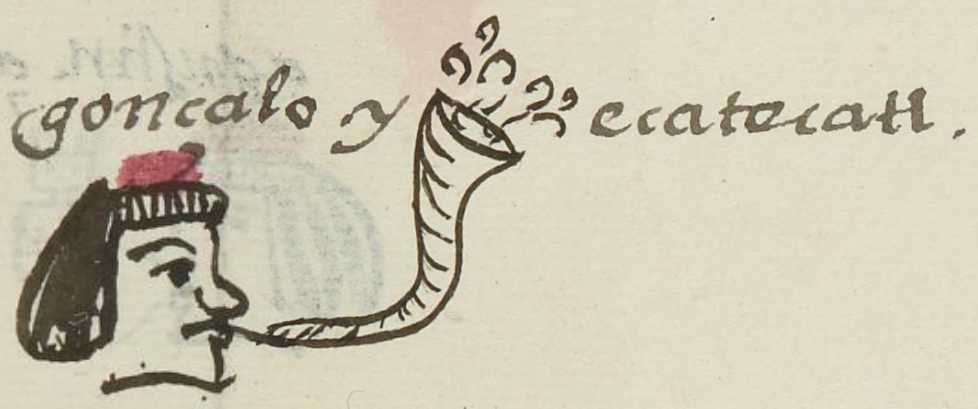Yecatecatl (MH664r)
This black-line drawing of the simplex glyph for the personal name or ethnicity of Yecatecatl (likely really someone from Ecatlan, which is still the name of a place in the modern state of Puebla) is attested here as a man’s name. The glyph shows a curving tube or instrument that rises up and widens into a bell shape at the end. Coming out of this instrument are at least six volutes, evocative of air (ecatl) or wind (ehecatl).
Stephanie Wood
The initial letter "i" or "y" is not entirely unusual for the start to this ethnicity. At least two other glyphs in this collection are glossed Yecatl. The start to these names is more commonly Eca-, even when Eheca- might be expected, given the iconography. A device for blowing wind is a diagnostic for Ehecatl, the divine force or deity of the wind. The lack of reduplication of the first syllable in the man's name by itself is not unusual. Ecatl can mean air or breath, while ehecatl is the usual way of writing wind. Wind has a notable importance in Nahua religion, often preceding the rain that was so essential for temporal agriculture. Ehecatl was a day sign in the 260-day divinatory calendar (tonalpohualli), which meant it ended up as a personal name for many people. In this case, the place name Ecatlan could refer to a settlement where there is much wind.
Stephanie Wood
1560
Jeff Haskett-Wood
viento, aliento, lugares, nombres de deidades, etnicidades, nombres de hombres

eca(tl), air, breath, and a name with an alternative spelling of Yecatl, https://nahuatl.wired-humanities.org/content/ecatl
eheca(tl)/Ehecatl, wind or the divine force or spirit of the wind, https://nahuatl.wired-humanities.org/content/ehecatl
yeca(tl), fresh water, https://nahuatl.wired-humanities.org/content/yecatl
-tecatl (affiliation suffix), person from, https://nahuatl.wired-humanities.org/content/tecatl
Uno de Ecatlan
Stephanie Wood
Matrícula de Huexotzinco, folio 664r, World Digital Library, https://www.loc.gov/resource/gdcwdl.wdl_15282/?sp=408&st=image.
This manuscript is hosted by the Library of Congress and the World Digital Library; used here with the Creative Commons, “Attribution-NonCommercial-ShareAlike 3.0 License” (CC-BY-NC-SAq 3.0).



